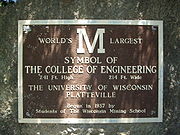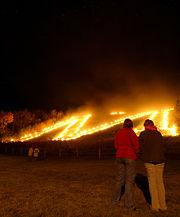
Platte Mound M
Encyclopedia



Whitewash
Whitewash, or calcimine, kalsomine, calsomine, or lime paint is a very low-cost type of paint made from slaked lime and chalk . Various other additives are also used...
ed stones on Platte Mound about four miles east of Platteville
Platteville, Wisconsin
Platteville is the largest city in Grant County in southwestern Wisconsin. The population was 11,224 at the 2010 census, growing 12% since the 2000 Census. Much of this growth is likely due to the enrollment increase of the University of Wisconsin–Platteville...
, Wisconsin
Wisconsin
Wisconsin is a U.S. state located in the north-central United States and is part of the Midwest. It is bordered by Minnesota to the west, Iowa to the southwest, Illinois to the south, Lake Michigan to the east, Michigan to the northeast, and Lake Superior to the north. Wisconsin's capital is...
. It is the largest letter "M" in the world. The letter is 241 feet (73.5 m) high, 214 feet (65.2 m) wide, with legs 25 feet (7.6 m) wide.
History
University of Wisconsin-PlattevilleUniversity of Wisconsin-Platteville
University of Wisconsin–Platteville is a public university located in Platteville, Wisconsin, United States. It is part of the University of Wisconsin System and offers both bachelor and master degrees...
students Raymond Medley and Alvin Knoerr worked at a Colorado
Colorado
Colorado is a U.S. state that encompasses much of the Rocky Mountains as well as the northeastern portion of the Colorado Plateau and the western edge of the Great Plains...
mine in the summer of 1936, where they saw a large letter "M" on the side of a hill that signified mining. They believed that a larger "M" should be written on the Platte Mound to represent Platteville miners. They created the first letter on the mound that winter. They wrote the letter "M" in deep snow, and it was visible for several weeks when a cold spell hit the area. The letter "M" was selected for the School of Mines at the university. Several students who went hiking in the same spot after the snow melted used large rocks to build one leg of a letter "M" while resting. The unfinished letter was so pronounced that engineering department head, H. B. Morrow, declared a field day for the department personnel and engineering students to complete the "M". Seniors surveyed the letter to make sure that it was larger than the "M" in Colorado. Underclassmen constructed the letter using borrowed picks, crowbars, and wheelbarrows from a local CCC
Civilian Conservation Corps
The Civilian Conservation Corps was a public work relief program that operated from 1933 to 1942 in the United States for unemployed, unmarried men from relief families, ages 18–25. A part of the New Deal of President Franklin D...
camp. The letter was constructed from limestone found on the mound. Morrow and other professors drove several miles away to inspect the work from a distance, and they recommended changes to counteract distortion from the slope of the mound. Work was completed about six months later and the letter was celebrated at that year's homecoming
Homecoming
Homecoming is the tradition of welcoming back alumni of a school. It most commonly refers to a tradition in many universities, colleges and high schools in North America...
on October 16, 1937. It was lit from a torch that was relayed 4.5 miles (7.2 km) from the school's Tech building. The illuminated letter was visible from 28 miles away.
Before 1940, the letter was lit only for homecoming. After World War II
World War II
World War II, or the Second World War , was a global conflict lasting from 1939 to 1945, involving most of the world's nations—including all of the great powers—eventually forming two opposing military alliances: the Allies and the Axis...
, the tradition changed to include lighting the letter on the evening of the spring Miner's Ball. The letter was neglected during World War II when few men were available. Female students noticed the general disrepair of the letter, which led to a custom of cleaning the letter in the fall and whitewashing it in April on the Thursday before the Miner's Ball. Life magazine
Life (magazine)
Life generally refers to three American magazines:*A humor and general interest magazine published from 1883 to 1936. Time founder Henry Luce bought the magazine in 1936 solely so that he could acquire the rights to its name....
reporter Francis Miller attended the April 29, 1949 lighting, where he witnessed 250 quart cans with corncobs lit around the outline of the letters. It took 23 minutes to relay the torch to the mound. His story appeared in Life on May 23, 1949.
Platte Mound is a one mile long and half mile wide mound that rises 450 feet (137.2 m) feet above its surroundings. The college had received permission to construct the letter from property owner William Snow. A Mr. Clausen from Racine
Racine, Wisconsin
Racine is a city in and the county seat of Racine County, Wisconsin, United States. According to 2008 U.S. Census Bureau estimates, the city had a population of 82,196...
, who later purchased the land, then donated it to the Board of State College Regents. The letter has been maintained by engineering students at the university since the mining engineering department closed in the 1990s. The Theta Tau
Theta Tau
ΘΤ Fraternity was founded in 1904 by four engineering students at the University of Minnesota in Minneapolis. As defined by the fraternity, the purpose of Theta Tau is to develop and maintain a high standard of professional interest among its members, and to unite them in a strong bond of...
engineering fraternity receives about $2,000 each year for maintenance.
See also
- Platte Mound M is at coordinates 42.76371299°N 90.40666580°W
- Hillside letters

